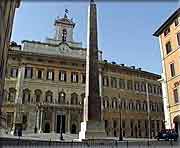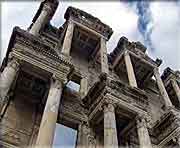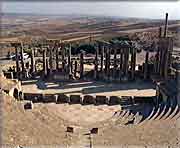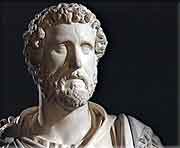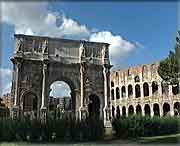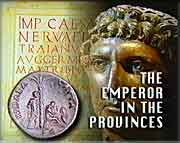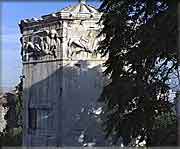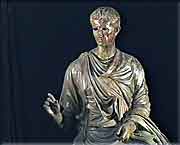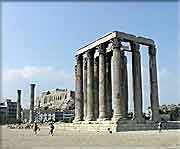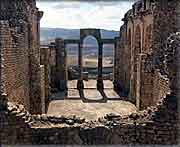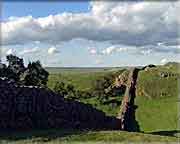|
CULTURE, IDENTITY AND POWER IN THE ROMAN EMPIRE (AA309) - 2000 onwards
- Introducing the Roman World
A brief introduction to the themes of "Culture, Identity and Power", the geographic areas of the Roman Empire discussed and the range of source materials used.
- Augustus and the Campus Martius
How did emperors use the appearance of Rome to reflect their own identity and power? This section takes a close look at the Campus Martius in Rome and its revitalisation under Augustus.
- Emperor & Empire
The emperor commanded a vast territorial empire inhabited by peoples of diverse origins and beliefs. How was the image of the emperor promoted in the provinces as a means of unification? And how were those provinces represented in Rome as a symbol of the emperor's power.
- Fora & Public Buildings
Using a variety of sources this section unpicks the archaeological remains of some of the features of the Forum Romanum and the Imperial Fora in Rome. Common elements recurred as the emperors manipulated the fora of Rome to glorify each new dynasty. The section continues by examining how building features were adopted and adapted by provincial towns, such as Ostia and Pompeii, to fit the individual urban identities of each town.
- Athens from Augustus to Hadrian
How was the city of Athens treated by invading Roman forces? What does the archaeological evidence reveal about the city's relationship with Rome, following Athens' capture by Sulla, under the Emperor Hadrian and through the workings of local benefactors?
- Cult and the City of Ephesus
This section examines the archaeological evidence for cult activity within the city of Ephesus - the city's long and close association with the cult of Artemis, the benefits bestowed upon it by the officially endorsed Emperor cult, together with the worship of a diverse number of gods brought to the city by traders from across the Empire. What evidence is there for the roles played by these different cults in shaping the city's urban development and how far did they combine to shape a coherent identity for the city?
- Culture & Identity in the Houses of the Roman Elite
Within Roman culture, it appears that the house had considerable symbolic value. How far did the organisation and decoration of the domestic space across the Empire provide evidence for the ways individuals created and displayed their own private identities and cultural affiliations. With particular reference to the houses of Pompeii (Italy), Ephesus (Turkey/Asia Minor), Thugga, Carthage & Bulla Regia (Tunisia/Africa Proconsularis).
- Archaeology at Arbeia
Lisa Nevett talks to Graeme Stobbs, Assistant Keeper of Field Archaeology and Alex Croom, Keeper of Archaeology about past and present archaeology at Arbeia.
- Image & Text on Tombstones
Val Hope uses the evidence from tombstones found in Pompeii, Colchester and South Shields to examine their contexts and to give guided readings.
- Rome's British Frontiers
With Dick Whittacker, Lindsay Allason-Jones and Lawrence Keppie discuss what evidence there is for life on the frontier zone of Hadrian's Wall in England, and the Antonine Wall in Scotland. What might the real function of these "walls" have been? And what's the evidence for cultural, and other, interactions between Roman soldiers and local people?
- The Boadicea Phenomenon
Janet Huskinson talks to Carolyn Williams about post-classical images of Boadicea, showing how her role has been reinvented to suit the needs of later societies.
- Presenting Roman Britain
Janet Huskinson talks to Peter Berridge from Colchester Museum, Lindsay Allason-Jones from the Museum of Antiquities, Newcastle-upon-Tyne, Tim Potter from the British Museum and Lawrence Keppie from the Huntarian Museum, Glasgow.
- Exploring Thugga
This section explores the ancient city of Thugga (in modern-day Tunisia). Thugga had been a flourishing city and centre of Numidian power, well before the kingdom of Numidia was added to the Roman Empire. But what survives of that African city and what evidence remains of the impact of Roman occupation on the city?
- Mosaic from Acholla
This short sequence analyses the mosaic of Dionysus from the Baths of Trajan at Acholla (now in the Bardo Museum, Tunis). This example shows how in this instance the African mosaic is reproducing motifs and styles of composition current in Italy at the time.
- Mosaic from La Chebba
This short sequence analyses the mosaic of Neptune & the Four Seasons (now in the Bardo Museum, Tunis). In this mosaic the figures are drawn from classical mythology but the style is a forerunner to a recognisable African style of mosaic found throughout the southern part of the central Mediterranean.
- Economic Power and Exchange: Africa and Rome
In the centre of modern Rome is a hill called the Monte Testaccio, which literally translates as "the mountain of pieces of pottery"? How did this mountain form and what other evidence is there for the trade between the provinces of the Empire and the city of Rome? With particular reference to the province of Africa Proconsularis (modern Tunisia), this section examines the trade routes to Rome, the commodities exploited and what this reveals about the relationship between this province and Imperial power.
- Herod and Judaea (Produced by Peter Walton for A292)
Herod the Great was one of the master builders of the ancient world. The programme surveys the remains of his buildings in modern Israel (much of the material is aerial footage) - his new towns, Caesarea and Samaria [Sebaste], the base of the Temple in Jerusalem and the Tomb of the Patriarchs in Hebron. The Citadel [David's Tower] is briefly examined before a more detailed study of Masada, the Winter Palace at Jericho, and finally Herodion.
This section was originally made for the course A293, and first transmitted in 1982.
- Four Faces of Rome
- Reconstructing Rome: The Grand Tour, Catharine Edwards
What epitomised Roman civilisation for the 18th & early 19th century "grand tourist"?
- Working the symbols: The Banner of the Operative Bricklayer's Society, Annie Ravenhill
A rich and detailed talk on the classical iconography and symbolism contained within The Banner of the Operative Bricklayer's Society.
- Silencing the Past: Roman Mummy Portraits, Dominic Montserrat
Through discussion of a selection of Roman Mummy Portraits, filmed at the British Museum, Dominic Monsterrat raises a range of issues about our responsibility to the past and how we interpret and represent it.
- Promoting the present: The Roman Empire in 50' and 60's Hollywood, Maria Wyke
With specific reference to "The Robe" (1953) and "The Fall of the Roman Empire" (1964), Maria Wyke explores the relationship between America, as portrayed through these films, and the Roman experience of Empire.
|

